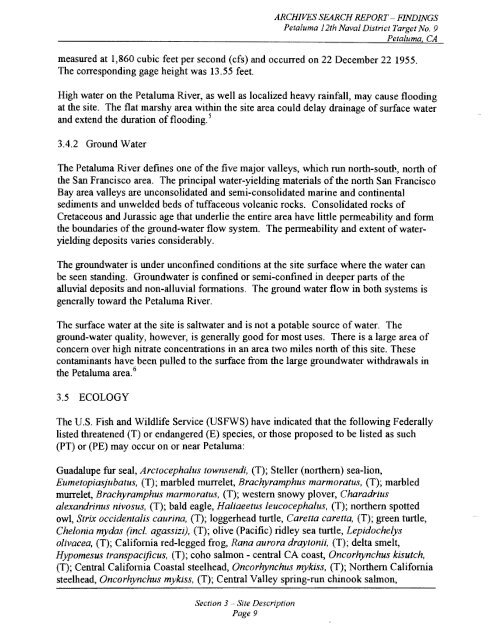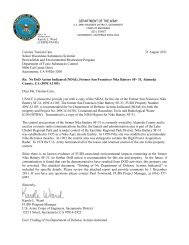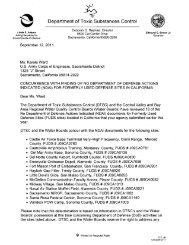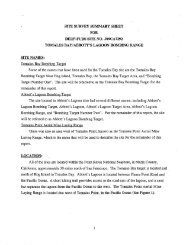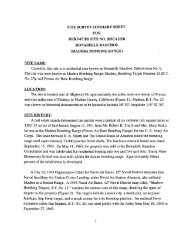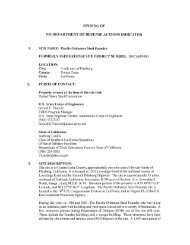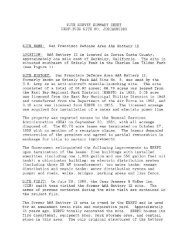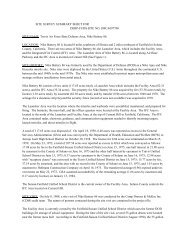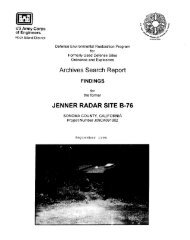Petaluma Bombing Target Archive Search Report ... - Corpsfuds.org
Petaluma Bombing Target Archive Search Report ... - Corpsfuds.org
Petaluma Bombing Target Archive Search Report ... - Corpsfuds.org
You also want an ePaper? Increase the reach of your titles
YUMPU automatically turns print PDFs into web optimized ePapers that Google loves.
ARCHIVES SEARCH REPORT - FINDINGS<br />
<strong>Petaluma</strong> 12th Naval District <strong>Target</strong> No. 9<br />
measured at 1,860 cubic feet per second (cfs) and occurred on 22 December 22 1955.<br />
The corresponding gage height was 13.55 feet.<br />
High water on the <strong>Petaluma</strong> River, as well as localized heavy rainfall, may cause flooding<br />
at the site. The flat marshy area within the site area could delay drainage of surface water<br />
and extend the duration of flooding5<br />
3.4.2 Ground Water<br />
The <strong>Petaluma</strong> fiver defines one of the five major valleys, which run north-south, north of<br />
the San Francisco area. The principal water-yielding materials of the north San Francisco<br />
Bay area valleys are unconsolidated and semi-consolidated marine and continental<br />
sediments and unwelded beds of tuffaceous volcanic rocks. Consolidated rocks of<br />
Cretaceous and Jurassic age that underlie the entire area have little permeability and form<br />
the boundaries of the ground-water flow system. The permeability and extent of water-<br />
yielding deposits varies considerably.<br />
The groundwater is under unconfined conditions at the site surface where the water can<br />
be seen standing. Groundwater is confined or semi-confined in deeper parts of the<br />
alluvial deposits and non-alluvial formations. The ground water flow in both systems is<br />
generally toward the <strong>Petaluma</strong> River.<br />
The surface water at the site is saltwater and is not a potable source of water. The<br />
ground-water quality, however, is generally good for most uses. There is a large area of<br />
concern over high nitrate concentrations in an area two miles north of this site. These<br />
contaminants have been pulled to the surface from the large groundwater withdrawals in<br />
the <strong>Petaluma</strong> area.6<br />
3.5 ECOLOGY<br />
The U.S. Fish and Wildlife Service (USFWS) have indicated that the following Federally<br />
listed threatened (T) or endangered (E) species, or those proposed to be listed as such<br />
(PT) or (PE) may occur on or near <strong>Petaluma</strong>:<br />
Guadalupe fur seal, Arctocephalus townsendi, (T); Steller (northern) sea-lion,<br />
Eumetopiasjubatus, (T); marbled murrelet, Brachyramphus marmoratus, (T); marbled<br />
murrelet, Brachyramphus marmoratus, (T); western snowy plover, Charadrius<br />
alexandrinus nivosus, (T); bald eagle, Haliaeetus leucocephalus, (T); northern spotted<br />
owl, Strix occidentah caurina, (T); loggerhead turtle, Caretta caretta, (T); green turtle,<br />
Chelonia mydas (incl. agassizi), (T); olive (Pacific) ridley sea turtle, Lepidochelys<br />
olivacea, (T); California red-legged frog, Rana aurora draytonii, (T); delta smelt,<br />
Hypomesus transpacrficus, (T); coho salmon - central CA coast, Oncorhynchus kisutch,<br />
(T); Central California Coastal steelhead, Oncorhynchus mykiss, (T); Northern California<br />
steelhead, Oncorhynchus mykiss, (T); Central Valley spring-run chinook salmon,<br />
Section 3 - Site Description<br />
Page 9


